Jan Swevers
Safe Motion Planning and Control Using Predictive and Adaptive Barrier Methods for Autonomous Surface Vessels
Oct 01, 2025Abstract:Safe motion planning is essential for autonomous vessel operations, especially in challenging spaces such as narrow inland waterways. However, conventional motion planning approaches are often computationally intensive or overly conservative. This paper proposes a safe motion planning strategy combining Model Predictive Control (MPC) and Control Barrier Functions (CBFs). We introduce a time-varying inflated ellipse obstacle representation, where the inflation radius is adjusted depending on the relative position and attitude between the vessel and the obstacle. The proposed adaptive inflation reduces the conservativeness of the controller compared to traditional fixed-ellipsoid obstacle formulations. The MPC solution provides an approximate motion plan, and high-order CBFs ensure the vessel's safety using the varying inflation radius. Simulation and real-world experiments demonstrate that the proposed strategy enables the fully-actuated autonomous robot vessel to navigate through narrow spaces in real time and resolve potential deadlocks, all while ensuring safety.
Decoupling Collision Avoidance in and for Optimal Control using Least-Squares Support Vector Machines
May 16, 2025Abstract:This paper details an approach to linearise differentiable but non-convex collision avoidance constraints tailored to convex shapes. It revisits introducing differential collision avoidance constraints for convex objects into an optimal control problem (OCP) using the separating hyperplane theorem. By framing this theorem as a classification problem, the hyperplanes are eliminated as optimisation variables from the OCP. This effectively transforms non-convex constraints into linear constraints. A bi-level algorithm computes the hyperplanes between the iterations of an optimisation solver and subsequently embeds them as parameters into the OCP. Experiments demonstrate the approach's favourable scalability towards cluttered environments and its applicability to various motion planning approaches. It decreases trajectory computation times between 50\% and 90\% compared to a state-of-the-art approach that directly includes the hyperplanes as variables in the optimal control problem.
Accelerated Reeds-Shepp and Under-Specified Reeds-Shepp Algorithms for Mobile Robot Path Planning
Apr 08, 2025Abstract:In this study, we present a simple and intuitive method for accelerating optimal Reeds-Shepp path computation. Our approach uses geometrical reasoning to analyze the behavior of optimal paths, resulting in a new partitioning of the state space and a further reduction in the minimal set of viable paths. We revisit and reimplement classic methodologies from the literature, which lack contemporary open-source implementations, to serve as benchmarks for evaluating our method. Additionally, we address the under-specified Reeds-Shepp planning problem where the final orientation is unspecified. We perform exhaustive experiments to validate our solutions. Compared to the modern C++ implementation of the original Reeds-Shepp solution in the Open Motion Planning Library, our method demonstrates a 15x speedup, while classic methods achieve a 5.79x speedup. Both approaches exhibit machine-precision differences in path lengths compared to the original solution. We release our proposed C++ implementations for both the accelerated and under-specified Reeds-Shepp problems as open-source code.
* 19 pages, 27 figures
Robustified Time-optimal Point-to-point Motion Planning and Control under Uncertainty
Jan 24, 2025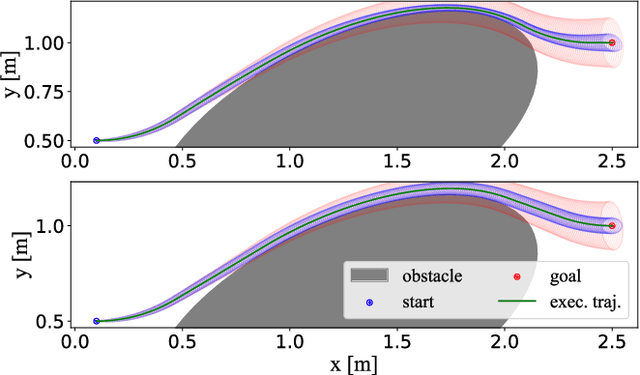
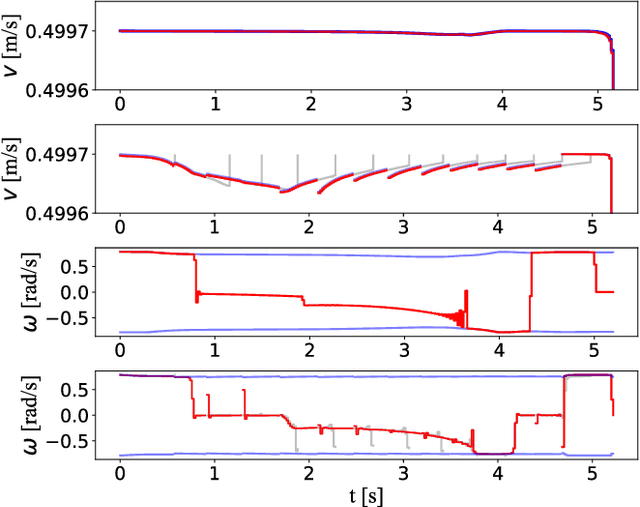
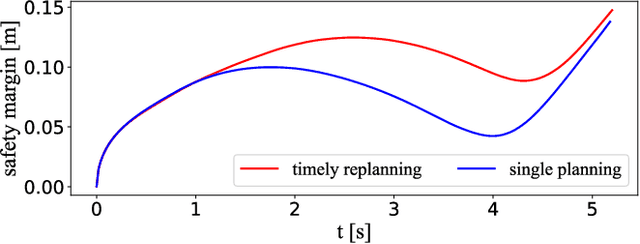

Abstract:This paper proposes a novel approach to formulate time-optimal point-to-point motion planning and control under uncertainty. The approach defines a robustified two-stage Optimal Control Problem (OCP), in which stage 1, with a fixed time grid, is seamlessly stitched with stage 2, which features a variable time grid. Stage 1 optimizes not only the nominal trajectory, but also feedback gains and corresponding state covariances, which robustify constraints in both stages. The outcome is a minimized uncertainty in stage 1 and a minimized total motion time for stage 2, both contributing to the time optimality and safety of the total motion. A timely replanning strategy is employed to handle changes in constraints and maintain feasibility, while a tailored iterative algorithm is proposed for efficient, real-time OCP execution.
Exact Wavefront Propagation for Globally Optimal One-to-All Path Planning on 2D Cartesian Grids
Sep 17, 2024



Abstract:This paper introduces an efficient $\mathcal{O}(n)$ compute and memory complexity algorithm for globally optimal path planning on 2D Cartesian grids. Unlike existing marching methods that rely on approximate discretized solutions to the Eikonal equation, our approach achieves exact wavefront propagation by pivoting the analytic distance function based on visibility. The algorithm leverages a dynamic-programming subroutine to efficiently evaluate visibility queries. Through benchmarking against state-of-the-art any-angle path planners, we demonstrate that our method outperforms existing approaches in both speed and accuracy, particularly in cluttered environments. Notably, our method inherently provides globally optimal paths to all grid points, eliminating the need for additional gradient descent steps per path query. The same capability extends to multiple starting positions. We also provide a greedy version of our algorithm as well as open-source C++ implementation of our solver.
Learning deformable linear object dynamics from a single trajectory
Jul 03, 2024
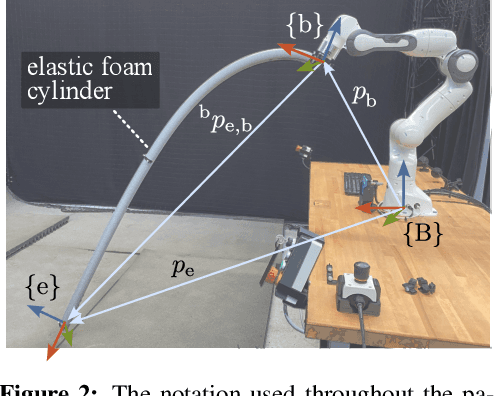
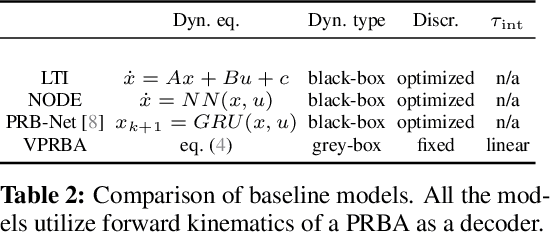

Abstract:The manipulation of deformable linear objects (DLOs) via model-based control requires an accurate and computationally efficient dynamics model. Yet, data-driven DLO dynamics models require large training data sets while their predictions often do not generalize, whereas physics-based models rely on good approximations of physical phenomena and often lack accuracy. To address these challenges, we propose a physics-informed neural ODE capable of predicting agile movements with significantly less data and hyper-parameter tuning. In particular, we model DLOs as serial chains of rigid bodies interconnected by passive elastic joints in which interaction forces are predicted by neural networks. The proposed model accurately predicts the motion of an robotically-actuated aluminium rod and an elastic foam cylinder after being trained on only thirty seconds of data. The project code and data are available at: \url{https://tinyurl.com/neuralprba}
Learning from Visual Demonstrations through Differentiable Nonlinear MPC for Personalized Autonomous Driving
Mar 22, 2024



Abstract:Human-like autonomous driving controllers have the potential to enhance passenger perception of autonomous vehicles. This paper proposes DriViDOC: a model for Driving from Vision through Differentiable Optimal Control, and its application to learn personalized autonomous driving controllers from human demonstrations. DriViDOC combines the automatic inference of relevant features from camera frames with the properties of nonlinear model predictive control (NMPC), such as constraint satisfaction. Our approach leverages the differentiability of parametric NMPC, allowing for end-to-end learning of the driving model from images to control. The model is trained on an offline dataset comprising various driving styles collected on a motion-base driving simulator. During online testing, the model demonstrates successful imitation of different driving styles, and the interpreted NMPC parameters provide insights into the achievement of specific driving behaviors. Our experimental results show that DriViDOC outperforms other methods involving NMPC and neural networks, exhibiting an average improvement of 20% in imitation scores.
An Efficient Solution to the 2D Visibility Problem in Cartesian Grid Maps and its Application in Heuristic Path Planning
Mar 11, 2024Abstract:This paper introduces a novel, lightweight method to solve the visibility problem for 2D grids. The proposed method evaluates the existence of lines-of-sight from a source point to all other grid cells in a single pass with no preprocessing and independently of the number and shape of obstacles. It has a compute and memory complexity of $\mathcal{O}(n)$, where $n = n_{x}\times{} n_{y}$ is the size of the grid, and requires at most ten arithmetic operations per grid cell. In the proposed approach, we use a linear first-order hyperbolic partial differential equation to transport the visibility quantity in all directions. In order to accomplish that, we use an entropy-satisfying upwind scheme that converges to the true visibility polygon as the step size goes to zero. This dynamic-programming approach allows the evaluation of visibility for an entire grid orders of magnitude faster than typical ray-casting algorithms. We provide a practical application of our proposed algorithm by posing the visibility quantity as a heuristic and implementing a deterministic, local-minima-free path planner, setting apart the proposed planner from traditional methods. Lastly, we provide necessary algorithms and an open-source implementation of the proposed methods.
Time-optimal Point-to-point Motion Planning: A Two-stage Approach
Mar 06, 2024Abstract:This paper proposes a two-stage approach to formulate the time-optimal point-to-point motion planning problem, involving a first stage with a fixed time grid and a second stage with a variable time grid. The proposed approach brings benefits through its straightforward optimal control problem formulation with a fixed and low number of control steps for manageable computational complexity and the avoidance of interpolation errors associated with time scaling, especially when aiming to reach a distant goal. Additionally, an asynchronous nonlinear model predictive control (NMPC) update scheme is integrated with this two-stage approach to address delayed and fluctuating computation times, facilitating online replanning. The effectiveness of the proposed two-stage approach and NMPC implementation is demonstrated through numerical examples centered on autonomous navigation with collision avoidance.
ASAP-MPC: An Asynchronous Update Scheme for Online Motion Planning with Nonlinear Model Predictive Control
Feb 09, 2024Abstract:This paper presents a Nonlinear Model Predictive Control (NMPC) scheme targeted at motion planning for mechatronic motion systems, such as drones and mobile platforms. NMPC-based motion planning typically requires low computation times to be able to provide control inputs at the required rate for system stability, disturbance rejection, and overall performance. Although there exist various ways in literature to reduce the solution times in NMPC, such times may not be low enough to allow real-time implementations. This paper presents ASAP-MPC, an approach to handle varying, sometimes restrictively large, solution times with an asynchronous update scheme, always allowing for full convergence and real-time execution. The NMPC algorithm is combined with a linear state feedback controller tracking the optimised trajectories for improved robustness against possible disturbances and plant-model mismatch. ASAP-MPC seamlessly merges trajectories, resulting from subsequent NMPC solutions, providing a smooth and continuous overall trajectory for the motion system. This frameworks applicability to embedded applications is shown on two different experiment setups where a state-of-the-art method fails: a quadcopter flying through a cluttered environment in hardware-in-the-loop simulation and a scale model truck-trailer manoeuvring in a structured lab environment.
 Add to Chrome
Add to Chrome Add to Firefox
Add to Firefox Add to Edge
Add to Edge